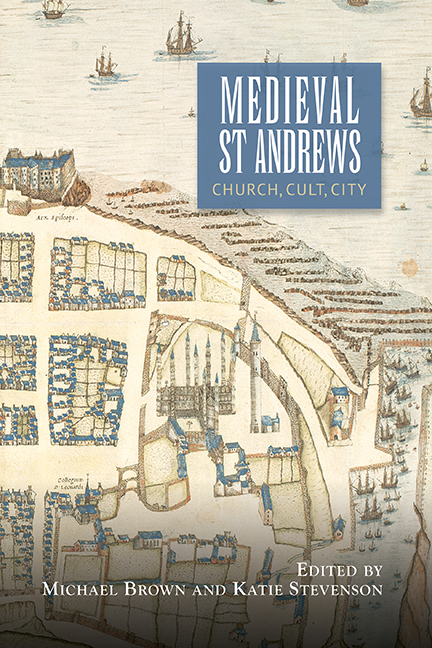Book contents
- Frontmatter
- Dedication
- Contents
- List of Illustrations, Charts and Tables
- Contributors
- Abbreviations
- 1 ‘Ancient Magnificence’: St Andrews in the Middle Ages: An Introduction
- 2 From Cinrigh Monai to Civitas Sancti Andree: A Star is Born
- 3 The Idea of St Andrews as the Second Rome Made Manifest
- 4 The Medieval Ecclesiastical Architecture of St Andrews as a Channel for the Introduction of New Ideas
- 5 When the Miracles Ceased: Shrine and Cult Management at St Andrews and Scottish Cathedrals in the Later Middle Ages
- 6 Religion, Ritual and the Rhythm of the Year in Later Medieval St Andrews
- 7 Living in the Late Medieval Town of St Andrews
- 8 The Burgh of St Andrews and its Inhabitants before the Wars of Independence
- 9 The Archaeology of Medieval St Andrews
- 10 Prelates, Citizens and Landed Folk: St Andrews as a Centre of Lordship in the Late Middle Ages
- 11 Augmenting Rentals: The Expansion of Church Property in St Andrews, c. 1400–1560
- 12 The Prehistory of the University of St Andrews
- 13 University, City and Society
- 14 The Medieval Maces of the University of St Andrews
- 15 Heresy, Inquisition and Late Medieval St Andrews
- Appendix 1 The St Andrews Foundation Account
- Appendix 2 The Augustinian' Account
- Appendix 3 The Boar' Raik
- Appendix 4 University of St Andrews Library, UYSL 110/6/4
- Index
- Miscellaneous Endmatter
12 - The Prehistory of the University of St Andrews
Published online by Cambridge University Press: 28 April 2017
- Frontmatter
- Dedication
- Contents
- List of Illustrations, Charts and Tables
- Contributors
- Abbreviations
- 1 ‘Ancient Magnificence’: St Andrews in the Middle Ages: An Introduction
- 2 From Cinrigh Monai to Civitas Sancti Andree: A Star is Born
- 3 The Idea of St Andrews as the Second Rome Made Manifest
- 4 The Medieval Ecclesiastical Architecture of St Andrews as a Channel for the Introduction of New Ideas
- 5 When the Miracles Ceased: Shrine and Cult Management at St Andrews and Scottish Cathedrals in the Later Middle Ages
- 6 Religion, Ritual and the Rhythm of the Year in Later Medieval St Andrews
- 7 Living in the Late Medieval Town of St Andrews
- 8 The Burgh of St Andrews and its Inhabitants before the Wars of Independence
- 9 The Archaeology of Medieval St Andrews
- 10 Prelates, Citizens and Landed Folk: St Andrews as a Centre of Lordship in the Late Middle Ages
- 11 Augmenting Rentals: The Expansion of Church Property in St Andrews, c. 1400–1560
- 12 The Prehistory of the University of St Andrews
- 13 University, City and Society
- 14 The Medieval Maces of the University of St Andrews
- 15 Heresy, Inquisition and Late Medieval St Andrews
- Appendix 1 The St Andrews Foundation Account
- Appendix 2 The Augustinian' Account
- Appendix 3 The Boar' Raik
- Appendix 4 University of St Andrews Library, UYSL 110/6/4
- Index
- Miscellaneous Endmatter
Summary
ST Andrews, both medieval and modern, is characterised by the quest for knowledge. The modern university proudly markets its historical status with the conveniently ambiguous strapline ‘Scotland's first university’, and it is undoubtedly the case that the atmosphere, traditions and environment of a place which has been a seat of learning for centuries are amongst the attractions which draw scholars to the ‘auld grey toun’. It is thus perhaps surprising that a degree of mystery still surrounds the foundation of the university, and that an event of such importance to Scotland's intellectual and cultural history remains relatively unexplored by historians. The first systematic attempt to describe both the motivation leading to the foundation and the process by which it was accomplished was not made until prompted by the 500th anniversary, celebrated (without obvious explanation of the choice of date) in 1911, apparently the first centenary to have been so honoured. However, since then remarkably little historiographical progress has been made regarding the events surrounding the foundation, which must of course be key to an understanding of the nature of the early institution and the town in which it was set. Yet there are obvious inconsistencies and uncertainties in what has become the accepted version of events, which justify a sceptical re-examination of the evidence.
The contemporary sources at our disposal are sparse. Walter Bower, a fifteenth- century abbot of Inchcolm, an Augustinian house set on a small island in the Forth only some 35 miles from St Andrews, related in his celebrated Scotichronicon that in 1410 ‘after Whitsunday an institution of higher learning of university standing made a start in the city of St Andrew of Kilrymont in Scotland when Henry de Wardlaw was the bishop of St Andrews and James Bisset was the prior there’. He proceeded to name three masters, subsequently (consequenter) joined by five more, who taught theology, canon law and arts, and revealed that they taught for two-and-a-half years before ‘at last’ (tandem) on 3 February 1413/14, papal privileges confirming the university's status were received in St Andrews. He then described in great detail the celebrations which marked that event: a peal of bells of all the town's churches, a formal reading of the papal bulls before the clergy, liturgical ceremonies, celebration of mass, preaching and a large ceremonial procession of, Bower claimed, ‘four hundred clergy besides lesser clerks and young monks’.
- Type
- Chapter
- Information
- Medieval St AndrewsChurch, Cult, City, pp. 237 - 267Publisher: Boydell & BrewerPrint publication year: 2017



